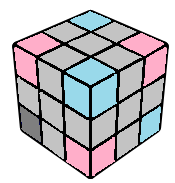
Corner "1"
As long as the bottom colour is yellow, this corner will be numbered "1" irrespective of the orientation along Y axis.

Corner "2"
As long as the bottom colour is yellow, this corner will be numbered "2" irrespective of the orientation along Y axis.

Corner "3"
As long as the bottom colour is yellow, this corner will be numbered "3" irrespective of the orientation along Y axis.

Corner "4"
As long as the bottom colour is yellow, this corner will be numbered "4" irrespective of the orientation along Y axis.



